Related Research Articles

Moto Guzzi is an Italian motorcycle manufacturer and the oldest European manufacturer in continuous motorcycle production.

Gilera is an Italian motorcycle manufacturer founded in Arcore in 1909 by Giuseppe Gilera (1887–1971). In 1969, the company was purchased by Piaggio.

MV Agusta is a high end motorcycle manufacturer founded by Count Domenico Agusta on 19 January 1945 as one of the branches of the Agusta aircraft company near Milan in Cascina Costa, Italy. The abbreviation MV stands for Meccanica (mechanics) Verghera, the hamlet where the first MVs were made. The modern headquarters and main production facilities are located in Varese, Italy on the shore of Lake Varese.

The MV Agusta 500cc Three (1965–1973) or MV Agusta Tre was a road racing motorcycle produced by the Italian manufacturer MV Agusta to compete in the 500 cc Grand Prix motorcycle racing World Championship. The motorcycle was introduced in 1966 to compete against the ever competitive Honda racing machines and was a bored out version of MV Agusta's highly successful 350 cc three cylinder. Giacomo Agostini won consecutive world championships in the 500 cc class with this motorbike from 1966 to 1972. In addition, MV Agusta won the Constructors' World Championships from 1967 to 1972. The MV Agusta Tre is considered the most successful racing motorcycle in history.

Capriolo, later called Aeromere, was the name of the motorcycle production arm of the Italian aircraft company Aeromere or Aero-Caproni. After World War II, the victorious Allies prohibited wartime aircraft and other military hardware suppliers from remaining in their previous industries, and Aero-Caproni would change its name to Capriolo and become one of several, including Aermacchi, MV Agusta, Vespa and Ducati, that switched to producing motorcycles or scooters. These companies did well until the mid-1960s, when the advent of affordable cars like the Fiat 500 removed the economic barrier that kept many Italians relying on motorcycles for basic transportation. Capriolo was typical of those that could not survive the transformation to a more export-orientated industry, with the US as the most important market. Motorcycle production ran from 1947 or 1948 until 1964.
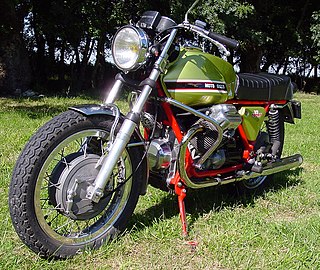
Lino Tonti was an Italian motorcycle engineer known for designing a number of sport and racing motorcycles in the 1950s and 1960s, and for creating his signature 'Tonti frame' for Moto Guzzi's 1971 V7 Sport, setting his stamp on all Moto Guzzis since.

The MV Agusta 600, also called the MV Agusta 600 4C and the MV Agusta 600 Turismo, was a motorcycle built by the MV Agusta company from 1966 to 1970. For the first time, a four-cylinder engine was fitted transversely to the direction of travel on a standard motorbike and cable-operated disc brakes were used. A total of 135 of this model were manufactured.
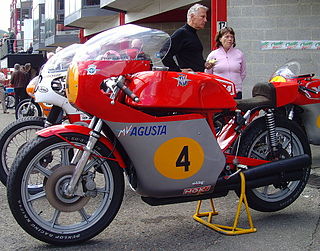
The MV Agusta 500cc road racers were motorcycles that the manufacturer MV Agusta built and which were used to compete in 500cc Grand Prix motorcycle racing series between 1950 and 1976. 18 500cc world championship titles were achieved with these machines ridden by John Surtees, Gary Hocking, Mike Hailwood, Giacomo Agostini and Phil Read between 1958 and 1974.

The MV Agusta 500 four-cylinder (1973–1976) was a racing motorcycle manufactured by the Italian company MV Agusta, for competing in the 500 cc series, the premier class of the FIM World Motorcycle Championship. With this motorcycle MV Agusta won the 1973 constructor's world champion and Phil Read won the 1973 and 1974 500 cc riders world championships.

The MV Agusta 500 6 cilindri was a prototype racing motorcycle built by the Varese company MV Agusta in 1957. Only one prototype was made.
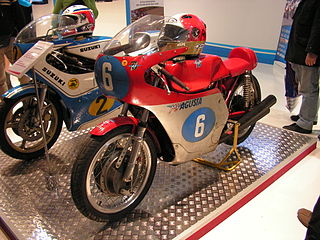
The MV Agusta 350 cc racers were motorcycles produced by MV Agusta between 1954 and 1976 and raced in the 350 cc motorcycle GP championships. 10 world titles were achieved by riders John Surtees, Gary Hocking and Giacomo Agostini on these machines.

The MV Agusta 350 6 cilindri was a prototype racing motorcycle built by the Varese company MV Agusta in 1957, for the 350 cc class of the FIM Motorcycle World Championship. The project was resurrected in 1968. Neither version was ever used in a race. The only surviving model is now in the MV Agusta factory museum.

The MV Agusta 250 Monocilindrica Bialbero was a 250 cc factory racer manufactured by the Italian brand MV Agusta from 1956 to 1959. With this machine 15 GPs, 2 Driver Championships and 2 manufacturers World Championships were won.
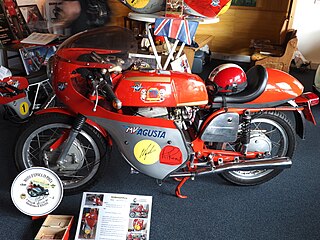
The MV Agusta 250 Bicilindrica was a 250 cc factory racing motorcycle manufactured by the Italian brand MV Agusta from 1957 to 1961. With this machine 11 GPs, 2 Driver Championships and 2 manufacturers World Championships were won.
The MV Agusta 203 Bialbero and MV Agusta 220 Bialbero were Italian factory racing motorcycles made by MV Agusta to compete in the 1955 250 cc World Motorcycle Racing Championship. The machine won three GPs and with it MV Agusta won that year's 250 cc Constructors Championship.

The MV Agusta 125 Bialbero was a 125 cc factory racer from the Italian brand MV Agusta, which was used between 1950 and 1960. The machine won 34 GPs, 6 rider's championships and one manufacturer's championship. The machine also won 4 Italian Championships and 10 National Championships in other countries.
Piero Remor was an Italian engineer and motorcycle constructor, best known for his work for the Gilera and MV Agusta brands.

The MV Agusta 350 Ipotesi (Hypothesis) was a motorcycle produced by the Italian manufacturer MV Agusta from 1975 to 1977. The machine was conceived by Italian designer Giorgetto Giugiaro and based on the previous 350 B Sport Elettronica model. 1,991 "Sports" and 350 “Turismo” machines were produced.

The MV Agusta 125 Sport SE was a sport motorcycle built from 1975 to 1977 by the Italian manufacturer MV Agusta. It was one of the last models to be produced by Meccanica Verghera at their Cascina Costa plant.
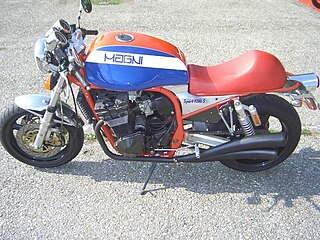
Magni is an Italian company that builds specialist motorcycles. The company is based in the city of Samarate in the province of Varese. Magni, in addition to building the bikes that bear its name, is also active in the construction of specials to order and a supplier of special parts for the restoration of MV Agusta classic motorcycles.
References
- ↑ "Arturo Magni". www.magni-bayern.de (in German). Magni Bayern. Retrieved 29 June 2019.
- 1 2 3 4 5 6 7 "Arturo Magni: 80 years of pure passion". www.magni.it. Retrieved 29 June 2019.
- 1 2 3 4 5 6 dePrato, Bruno (4 December 2015). "ARTURO MAGNI: 1925-2015, MV Agusta Race Manager Dies at 90". Cycle World . Retrieved 29 June 2019.
- 1 2 "Magni Motorcycles: A Brief History of the Italian Marque". cybermotorcycle.com. Retrieved 29 June 2019.
- ↑ Walker, Mick (1998). Mick Walker's Italian Racing Motorcycles. Redline Books. p. 209. ISBN 9780953131112.
- ↑ Cathcart, Allan. "Moto Magni A Family Affair". www.magzter.com. Magzter . Retrieved 29 June 2019.
- 1 2 3 "Obituary: Arturo Magni, 1925-2015". Motorcycle News. 2 December 2015. Retrieved 29 June 2019.
- ↑ Walker, Mick (1998). Mick Walker's Italian Racing Motorcycles. Redline Books. p. 63. ISBN 9780953131112.
- ↑ Egan, Peter (January 2000). Australia. Cycle World Magazine. p. 59.
- ↑ Alan, Cathcart (January 1996). Cafe-racer Comeback. Cycle World Magazine. p. 67.